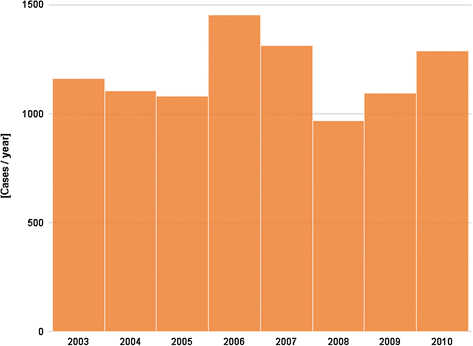Epidemiological situation of Lyme borreliosis in Belgium, 2003 to 2012
- PMID: 26146553
- PMCID: PMC4490618
- DOI: 10.1186/s13690-015-0079-7
Epidemiological situation of Lyme borreliosis in Belgium, 2003 to 2012
Abstract
Background: Some studies show that the incidence of Lyme borreliosis is increasing in different European countries. In order to evaluate if this is also the case in Belgium, different data sources were consulted to describe the epidemiology of Lyme borreliosis in the country during the last decade.
Methods: Data from two databases were analyzed for the time period 2003-2010 and 2003-2012 for respectively: the registration of minimal clinical data from Belgian hospitals (principal and secondary diagnosis), and a sentinel laboratory network reporting positive laboratory results.
Results: The number of hospitalized cases per year remained stable between 2003 and 2010, ranging from 970 (in 2008) to 1453 (in 2006), with a median of 1132.5 cases per year. Between 2003 and 2012, yearly fluctuations in the number of positive tests were reported by the sentinel laboratory network (with a minimum of 996 positive tests in 2007 and a maximum of 1651 positive tests in 2005), but there is no increasing trend over the study period (median = 1200.5 positive tests per year). The highest incidence rates of hospitalization and the highest reported incidence of positive laboratory results are registered in the provinces of Luxemburg, Limburg, Flemish Brabant and Antwerp, with a typical seasonal pattern (peak in September). The age groups affected most are those from 5 to 14 years and 45 to 69.
Conclusion: Based on hospital records and laboratory results, no increasing trend in Lyme disease was observed over the 2003-2012 period in Belgium. These results are in line with the stable incidence of erythema migrans reported by a sentinel network of general practitionners between 2003 and 2009. Multi-source surveillance of vector-borne diseases should be further implemented.
Keywords: Belgium; Epidemiology; Lyme borreliosis.
Figures






References
-
- Bigaignon G, Tomasi JP, Goubau P, Martin P, Pierard D, Sindic CJ, et al. A clinical and sero-epidemiological study of 190 Belgian patients suffering from Lyme borreliosis. Acta Clin Belg. 1989;44:174–81. - PubMed
-
- Coumou J, van der Poll T, Speelman P, Hovius JW. Tired of Lyme borreliosis. Lyme borreliosis in the Netherlands. Neth J Med. 2011;69:101–11. - PubMed
-
- Rizzoli A, Hauffe H, Carpi G, Vourc HG, Neteler M, Rosa R. Lyme borreliosis in Europe. Euro Surveill. 2011, 16. Pii: 19906. - PubMed
LinkOut - more resources
Full Text Sources
Other Literature Sources

